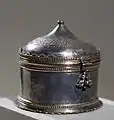
A pyx or pix (Latin: pyxis, transliteration of Greek: πυξίς, boxwood receptacle, from πύξος, box tree) is a small round container used in the Catholic, Old Catholic and Anglican Churches to carry the consecrated host (Eucharist), to the sick or those who are otherwise unable to come to a church in order to receive Holy Communion. The term can also be used in archaeology and art history to describe small, round lidded boxes designed for any purpose from antiquity or the Middle Ages, such as those used to hold coins for the Trial of the Pyx in England.
Usage
The word pyx comes from the Greek word πυξίς, pyxis 'box, receptacle'. (The Greek-like plural, pyxides, has given way to pyxes in English.) While the word may be applied to any covered carrier, in modern usage the term "pyx" usually denotes a small, flat, clamshell-style container, often about the size of a pocket watch and usually made of brass or other metals,[1] traditionally lined with gold.[2] A fabric or leather pouch for carrying a pyx is known as a burse. Typically, this kind of burse can be securely closed and is fixed with cords so that the priest, deacon, or extraordinary minister of Holy Communion can affix it to his or her person during transport to prevent the consecrated host(s) from being accidentally lost.
These objects, and others, such as the lunette (and the monstrance that holds it) that contain a consecrated host, are normally kept within the church tabernacle when they are not being carried. The tabernacle may be behind the main altar, at a side altar, or within a special Eucharistic chapel.
Liturgical history
In late antiquity, the custom developed in the East of suspending a vessel in the form of a dove (Greek: peristerion, Latin: peristerium) over the altar, which was used as a repository for the Blessed Sacrament. This custom is mentioned by Gregory of Tours in his Life of Saint Basil, and in several ancient French documents. The custom probably came to France from the East; it never seems to have existed in Italy.[3] Examples of this practice may still be found in use today; for instance, in the Cathedral of the Dormition in Moscow.
In Eastern Christianity
In the Eastern Orthodox and Greek Catholic Churches, the pyx (Russian: даро́носица, romanized: darónositsa) is the small "church tabernacle" which holds the Lamb (Host) that is reserved for the Liturgy of the Presanctified Gifts during Great Lent. This pyx may be either kept on the Holy Table (altar) or on the Prothesis (Table of Oblation) on the north side of the sanctuary.
Gallery
 Silver gilt pyx, south of France or Spain, 15th century (Musée de Cluny)
Silver gilt pyx, south of France or Spain, 15th century (Musée de Cluny) Bronze pyx for carrying the consecrated Host
Bronze pyx for carrying the consecrated Host Eucharistic dove (Walters Art Museum)
Eucharistic dove (Walters Art Museum) Rock crystal with copper-gilt mounts pyx from 20th century (Hunt Museum)
Rock crystal with copper-gilt mounts pyx from 20th century (Hunt Museum)
See also
Notes and references
- ↑
Compare:
Watkin, Aelred, ed. (1947). Inventory of church goods, temp. Edward III. Volume 19 of Norfolk Record Society; Part 2 of Inventory of church goods, temp. Edward III. Translated by Watkins, Aelred. Norfolk Record Society. p. lxxxiii. Retrieved 4 December 2023.
Few descriptions of the pyx are given. [...] With regard to materials we have more evidence: silver is by far the most common, twenty-nine silver pyxes are listed, of which twenty-two were gilt. [...] Fifteen pyxes of ivory are recorded, four of brass, four of latten, two of copper, one of wood and one of pewter. [...] Therefore in the majority of churches the pyx over the altar consisted of a silver-gilt or ivory coffer [...].
- ↑
Compare:
Middleton-Stewart, Judith (2001). "Gilding the Liturgy". Inward Purity and Outward Splendour: Death and Remembrance in the Deanery of Dunwich, Suffolk, 1370-1547. Studies in the history of medieval religion, ISSN 0955-2480, Volume 17 (revised ed.). Woodbridge, Suffolk: Boydell & Brewer. p. 183. ISBN 9780851158204. Retrieved 4 December 2023.
Gold, silver, ivory or copper gilt lined the inner [pyx] compartment so that only precious material would come into contact with the body of Christ, and, on the outside, enamelling might add a touch of luxury.
- ↑ Catholic History (March 1997), "Dove. Symbol of the Holy Ghost", The Seraph, vol. XVII No. 7, retrieved 2007-08-01
External links
- Pyx article from Catholic Encyclopedia
- A.S. Duncan-Jones and D. C. Dunlop, The Aumbry and Hanging Pyx (Warham Guild, 1925)